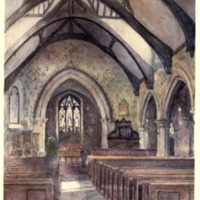Description
Marcus Huish visits, in 1907, St Laurence's Church, Chorley, the burial place of the Standish family. The Standish pew was described by Pevsner as "the best example of its type in North Lancashire" and had become another point of interest on the Mayflower tourist trail (although there is no evidence that Captain Miles Standish ever sat on it). Although Huish describes the small building as not having ‘a picturesque interior’, Elizabeth Chettel’s watercolour provides an attractive illustration of the small rural church and the Standish pew. As Huish puts it:
"Chorley Church, although it curiously enough contains no monuments to the Standish family, was their burial-place for many generations, and has been connected with them from time immemorial. […]
The church, as will be seen from Miss Chettle's drawing, has not a picturesque interior. Although the chancel was appropriated to the family, as was the usage, the Standish pew, which is the most remarkable feature of the building, is in the nave, and balances the pulpit. It is distinguished by oak panelling and a canopy carried up the wall decorated with quaint figures, escutcheons, and columns, between which are two seats for the knight and his dame. The Standish arms are to be found in the chancel window and on the exterior buttresses of the church. In the window they are combined with those of the Widdringtons, a name which carries us back to Chevy Chase, where one of them
When his legs were smitten off
He fought upon his stumps.
To this church Miles Standish must certainly oft times have resorted. That he imbibed Puritanical doctrines under the preaching of the word here is more doubtful, for the better-to-do gentry hereabouts were for the most part still of the Roman faith, and the other branch of the Standishes were so until recent date; in fact, it was at Standish Hall that the Lancashire plot for replacing the Stuarts was hatched."
In 1920, 'Standish Country' was one part of the 300th anniversary celebrations.

